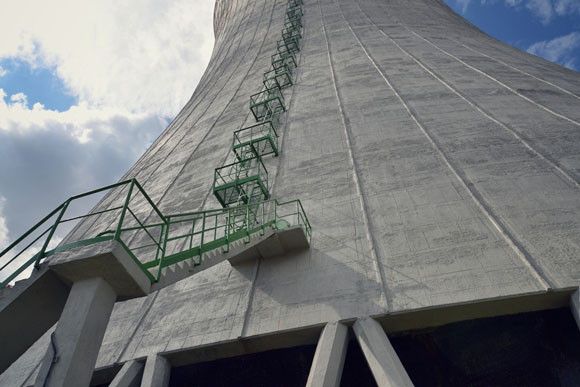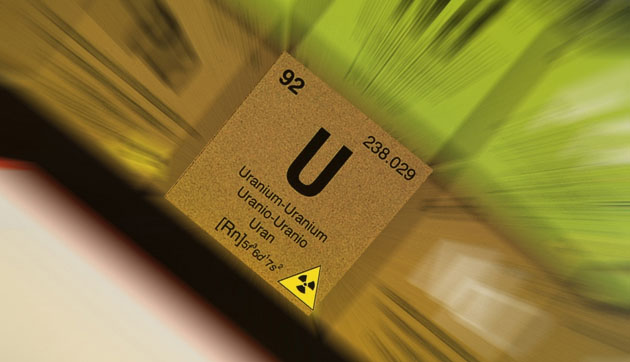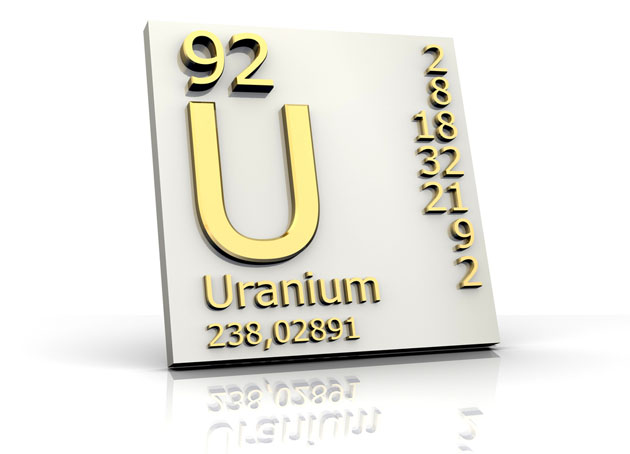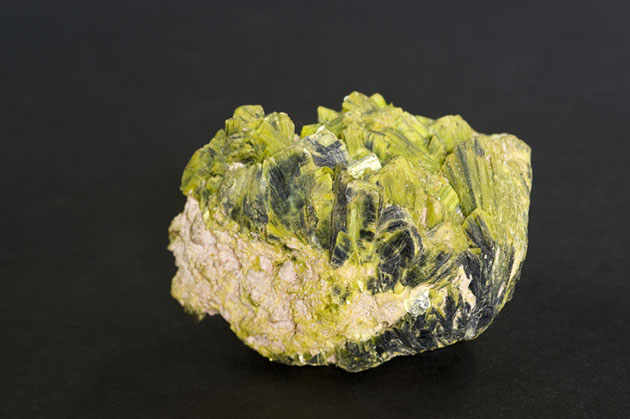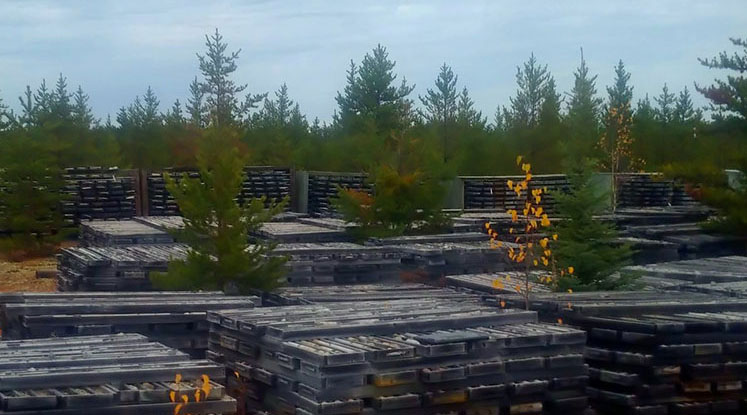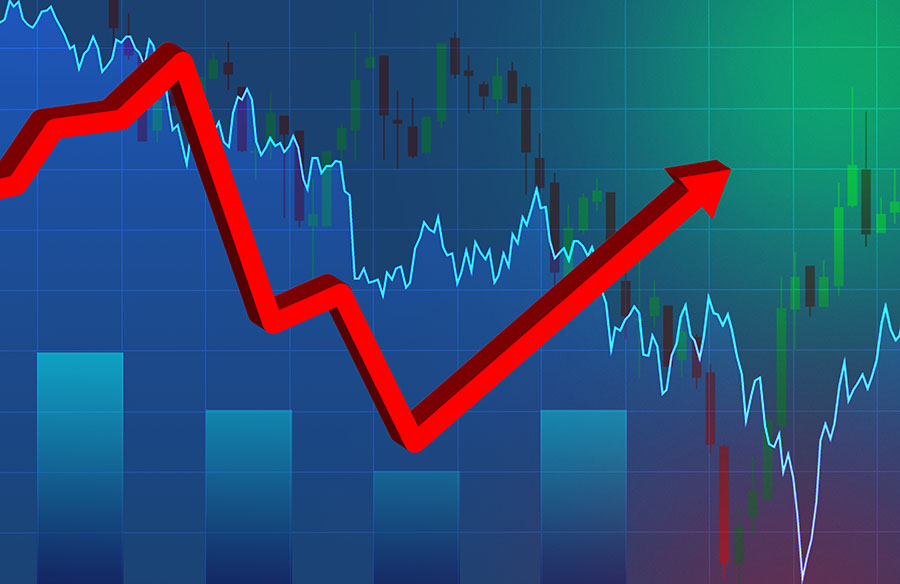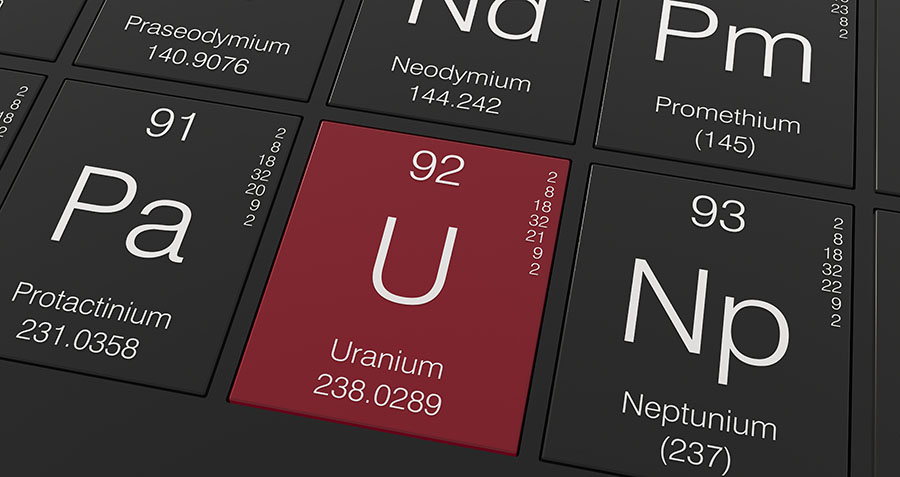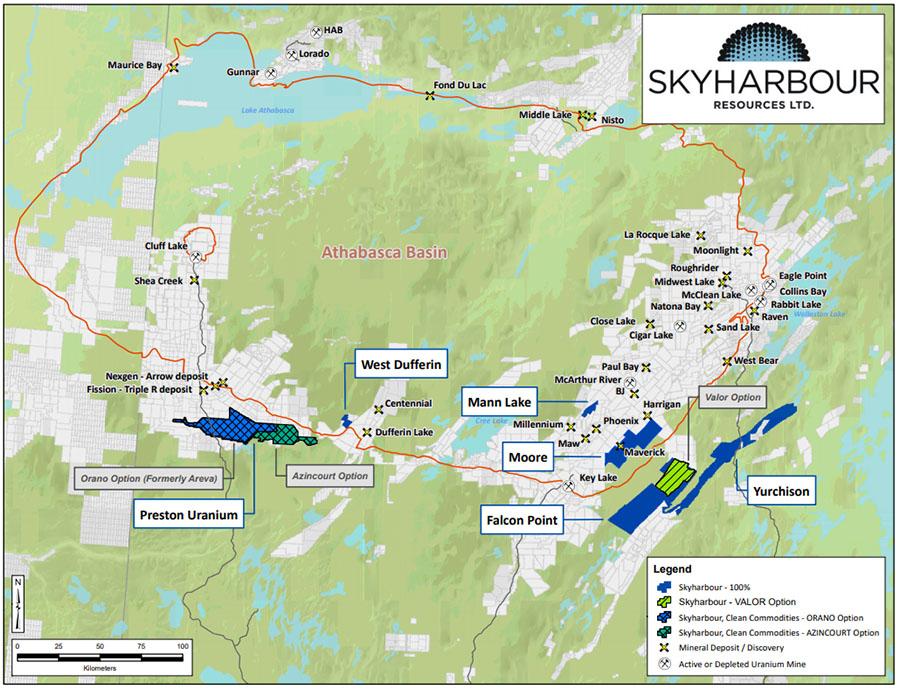TICKERS: BNNLF, CCO; CCJ, DML; DNN, EFR; UUUU, , MAW; MWSNF; MRY, MGA, PDN, RGT, URG; URE, , UEC
Geordie Mark: Catalysts, Not Uranium Prices, Grow Stocks
Interview
Source: George Mack of The Energy Report (8/2/11)
 Because of ongoing nuclear power development in China, Africa and the Middle East, uranium prices could bounce back to pre-Fukushima levels of $70/lb. in 2012, says Geordie Mark, a research analyst at Haywood Securities. Instead of waiting for prices to rebound, some mining companies are moving ahead with regulatory and construction projects to drive value. In this exclusive interview with The Energy Report, Mark points to the ones that could be poised to pay off for investors when the market turns.
Because of ongoing nuclear power development in China, Africa and the Middle East, uranium prices could bounce back to pre-Fukushima levels of $70/lb. in 2012, says Geordie Mark, a research analyst at Haywood Securities. Instead of waiting for prices to rebound, some mining companies are moving ahead with regulatory and construction projects to drive value. In this exclusive interview with The Energy Report, Mark points to the ones that could be poised to pay off for investors when the market turns.
Geordie Mark: Changing political sentiment toward nuclear power in advanced economies like Germany, Switzerland and Italy will have a tangible effect on uranium demand in the next 10 years. However, we really don't see it affecting the main growth picture in advancing economies of China and India. We're also looking for growth out of South Korea, Russia and other new entrants, probably the United Arab Emirates (UAE) and Saudi Arabia. These growing countries are looking to diversify their energy base.
TER: How big are the growing nuclear power users in Africa, UAE and Southwest Asia compared to China?
GM: I don't see these areas being equal drivers. Nuclear power is a significant part of China's growth strategy. That is evidenced by the government's target of 40 gigawatts of electric capacity by 2015. That represents some significant, real growth. China has a number of reactors under construction now, well ahead of the rest of the world. The other nations you mentioned certainly play a potential growth role about 5-10 years out. For nearer-term suppliers, the bigger demand sinks are those countries that either have a significant number of reactors under construction or plan to in the next three to five years.
TER: Recently, uranium was selling for around $51/lb. and trending down. Is the price finding support?
GM: We are in the slow, summer siesta period with fewer volumes being transacted on the spot market. The average for the year is about $61/lb. We see support at or around the low-$50/lb. range this time of year. We certainly are looking for strength in the commodity price coming into Q4 as purchasers look for discretionary demand for 2012, and for any contract shortfalls to come into the market around that time.
TER: What is the breakeven price for a pound of uranium for small producers compared to the bigger producers?
GM: We are still looking at some of the producers having expected cash costs in the low $30/lb. range on average. That would be Paladin Energy Ltd. (TSX:PDN; ASX:PDN). Denison Mines Corp. (TSX:DML; NYSE.A:DNN) is probably looking at the $50/lb. range. It is a marginal producer leveraged to the uranium price. The new entrants for in-situ recovery (ISR) uranium production out of the U.S. are Uranium Energy Corp (NYSE.A:UEC) and, potentially next year, Uranerz Energy Corp. (TSX:URZ; NYSE.A:URZ). They are coming in around the mid-$20/lb. to low $30/lb. price range. So, we are still looking at many of those companies being able to continue to operate under those conditions. But, certainly, we don't see the current price being a stimulus for the development of large-scale projects that involve significant capital investment.
TER: You forecast that by Q4 of this year, you would see some strength. What is your forecast for uranium now?
GM: For this year, we are looking for an average of around $60/lb. So, we see some strengthening in price from where it is today. Next year, we are looking at $70/lb. and our long-term projection is $75/lb.
TER: So, you see uranium production and pricing getting back to what it was.
GM: Yes. We see a slow recovery coming back up to what we were starting to see at the end of last year, but this is expected to take some time as the market progressively crystallizes a picture for tomorrow's supply-demand equation. The main uncertainty will be around what happens in Japan with the reactor operations, and whether additional countries join Germany in walking away from nuclear power.
TER: Could some of the undamaged reactors possibly come back online anytime soon?
GM: We have currently written those reactors off along with expectations for other reactor units to be constructed at that site, and within Japan.
TER: What about the regulatory picture? I know that it's different for each jurisdiction. But, what does it look like now, particularly on the mining side?
GM: We see enhanced project regulation and oversight on mining operations going forward. This will most likely result in more protracted permitting and more stringent requirements for mining projects and processing plants. We also expect that stakeholders will be more engaged during the permitting processes. All of these factors likely will culminate into greater review periods. For that reason, we have delayed our commissioning dates for a number of the larger development-stage projects undertaking project permitting and licensing. Concurrently, the events in Japan and the political shakeout across various European nations have led to softening the front end of our demand curve. These two factors have led to an overall smaller supply-demand picture for the next several years, when China's growth plans will have an even greater impact on the sector's size.
TER: Do you see institutional investors dipping their toes back into uranium mining companies? Is this a good time to reenter the market through equities?
GM: Well, we are seeing some interest from institutional investors looking at low-equity valuations out there. They are largely looking at large-cap producers such as Cameco Corp. (TSX:CCO; NYSE:CCJ) and other larger producers. Investors currently participating in the markets are those who believe in the long-term viability of the sector and have had that view for some time. Investors waiting on the sidelines comprise a significant proportion of the investor base and are fundamentally uncertain about the sector's trajectory post March 11.
In terms of investment, we have certainly seen lowering in equity valuations on simplistic enterprise value (EV)/lb. metrics as well as forward cashflow and EBITDA (earnings before interest, taxes, depreciation and amortization) multiples. Equities across the board have obviously taken a hit with earlier-stage companies commonly taking the brunt of the negative sentiment.
TER: When it comes to producers, are investors looking for special situations, discovery stories, near-term producers, mergers and acquisitions or turnaround stories? Are there any special themes?
GM: I think investors are looking for value within the sector. That can be translated as a company either witnessing good production growth potential, or nearing production having mitigated risk by receiving relevant permits and licenses. It could also be a company that has shown significant potential for resource growth. So, there is still investment potential. There is still interest in the sector, but investors are far more selective.
TER: It looks like over the last six months, the unweighted basket of uranium stocks has lost nearly half its market cap. Has this affected its ability to raise funds for capital expenditures? And, if so, are there some good acquisition targets in the pile?
GM: Absolutely. I would like to take a step back to say that I think a number of company boards in the sector were cognizant of the 2008 financial crisis and the requirements to have significant working capital to keep their main projects going. Given that backdrop, many companies raised cash in late 2010 and early 2011 to keep projects progressing and to maintain other objectives, e.g., continue with permitting, maintain resource definition programs and undertake exploration. So, many companies have a good position to keep going. That being said, post-March 11 there has been a tangible lessening in the ability of companies in the sector to raise capital for exploration and large-scale development projects. Low stock prices have led to companies cutting back on work programs to better maintain working capital positions, and to minimize any potential future dilution.
The bottom line is that we are still looking for value. We are looking for acquisition targets. We still see that the uranium sector is very much a strategic commodity. There are still strategic acquisitions in the space for large, exploitable resources in uranium mining-friendly jurisdictions. One company in this category is Bannerman Resources Ltd. (TSX:BAN; ASX:BMN), which recently had a proposed cash offer of just over AUD$0.60 by Hanlong Mining Investment because it holds a significant asset in Namibia. We also saw earlier this year Kalahari-Minerals (LSE:KAH), the major shareholder of Extract Resources (TSX:EXT, ASX:EXT), engage in potential acquisition discussions with China's Guangdong Nuclear Power Corporation. So, we still see that large-scale resources represent strategic assets independent of where equity prices stand. Given the low equity valuations, these types of assets are even more prone to sovereign interests and other parties trying to lock up supply.
TER: You clearly don't believe $0.61 is going to fly, do you? Your target price is better than 100% implied return on Bannerman.
GM: We have a $0.90 target on the company based on our future commodity price expectations. Our view was that the proposal was opportunistically timed. We think the Etango project in Namibia represents one of the few projects out there that could be in production within four or so years. A number of other parties could seek an interest with Bannerman or engage in a joint venture for exposure to production. We still see more value than the offer that Hanlong put out.
TER: Hanlong probably wanted to see if the market would bid on the company.
GM: Obviously, Hanlong wanted to engage with Bannerman on potential acquisition. We understand that Bannerman will continue dialogue with Hanlong over the next period. But this period is not exclusive so the company can still discuss other options with other third-party interests.
TER: A ridiculously low bid, wouldn't you think? I believe you calculated that the bid valued the Etango project at about $0.85/lb. U308.
GM: That's correct, our estimates placed the bid with an implied EV/lb. metric of significantly less than $1/lb. U3O8. Compare that to the recent acquisition of Mantra Resources Ltd., which was based on implied EV/lb. somewhere near $9.
TER: Any other ideas that you might have for investors?
GM: Sure. We see Uranium Energy Corporation as an exciting story out of Texas. We are looking at the company's continued production expansion as a big catalyst. We see the world's next new uranium producer as Uranerz Energy in Wyoming. The company just received its NRC (Nuclear Regulatory Commission) source materials license for Nichols Ranch, which we believe is now under construction. We see catalysts for Ur-Energy Inc. (NYSE.A:URG; TSX:URE) in permitting advancements, which we expect it to achieve throughout this half of the year for the Lost Creek Project in Wyoming. We are also looking at other catalysts for resource growth and/or exploration discovery. These companies include Mawson Resources Ltd. (TSX:MAW; OTCPK:MWSNF; Fkft:MRY), which has a very intriguing system in Finland, called Rompas. It seems to be a unique uranium-gold system. That company is doing some new, fundamental exploration at the moment. Also, Kivalliq Energy Corp. (TSX.V:KIV) has the Lac Cinquante Deposit that recently had a maiden resource defined of just over 14 Mlb. U3O8 at a grade 0.79%. There is a big drilling program being undertaken on the project area this year. This will test for resource expansion and exploration discovery. Meanwhile, Rockgate Capital Corp. (TSX:RGT) has the Falea Project in Mali where the company has already defined a significant uranium-silver resource base. The company is aiming to increase that resource base throughout the year. This goes to show that some companies are attempting to add value to their asset base independent of where the uranium price is today, thereby attempting to differentiate themselves from their peers.
TER: You had a target price of $0.70 on Energy Fuels Inc. (TSX:EFR), representing almost a double. What is the growth driver there?
GM: I think the growth driver for Energy Fuels ultimately relates to resolution of current litigation. The company is permitted for its Piņon Ridge mill. The main thing there would be for it to lock up an agreement to enter construction for the Piņon Ridge mill and start rehabilitating the Energy Queen Mine in Utah.
TER: You have a $0.65 target price on Mega Uranium Ltd. (TSX:MGA). That represents approximately a 76% implied return from here. What about the growth driver there?
GM: I think the main growth driver for the company correlates to the Lake Maitland Project in Western Australia and potential for resource growth in the short term. Mega Uranium also has potential for value addition through other projects in Australia. However, in the near term, we are looking at additional work in Lake Maitland and incremental permitting progress over the next few years. We see that project as one of the few potential projects in Australia that can enter production over the nearer term.
TER: Geordie, you mentioned the materials license approval for the Nichols Ranch ISR project that Uranerz recently received. That obviously derisked the project, but do you attach any other significance to this as far as the general regulatory scale?
GM: Well, Uranerz obviously took a very big step by entering the construction phase after the issuance of the NRC license. For the sector, it's not the first new materials license that the NRC has given recently. It did grant Uranium One's Moore Ranch Project a materials license last year. This project is also in Wyoming. Continued licensing shows that while it takes some time to go through the permitting process, if you have the right project and take the right steps, you can incrementally progress through permitting and licensing. So, I think it means effectively that the doors are most definitively still open, but I do not think that Uranerz's NRC license is a panacea for all projects. In our opinion, the most likely company to step through that process next is Ur-Energy.
Dr. Geordie Mark, a research analyst with Haywood Securities, focuses principally on uranium companies involved in exploration, development and production. He joined Haywood Securities from the junior exploration sector, where he was vice president of exploration for Cash Minerals, which concentrated on uranium and iron oxide-copper-gold targets across Canada. Immediately prior to joining the exploration industry full-time, Dr. Mark lectured in economic geology at Monash University, Australia and served as an industry consultant. He completed his Ph.D. in geology in 1998 at James Cook University's Economic Geology Research Unit in Australia, specializing in aqueous geochemistry and igneous petrology applied to ore-forming systems.
Want to read more exclusive Energy Report interviews like this? Sign up for our free e-newsletter, and you'll learn when new articles have been published. To see a list of recent interviews with industry analysts and commentators, visit our Exclusive Interviews page.
DISCLOSURE:
1) George Mack of The Energy Report conducted this interview. He personally and/or his family own shares of the following companies mentioned in this interview: None.
2) The following companies mentioned in the interview are sponsors of The Energy Report: Bannerman Resources, Uranium Energy, Uranerz Energy, Ur-Energy Inc., Mawson Resources Ltd., Mega Uranium, Energy Fuels Inc.
3) Geordie Mark: I personally and/or my family own shares of the following companies mentioned in this interview: Paladin Energy. I personally and/or my family am paid by the following companies mentioned in this interview: None.
4) Geordie Mark: Haywood Securities, Inc. has reviewed lead projects of Bannerman Resources Ltd., Energy Fuels Inc. and Mega Uranium Ltd. and a portion of the expenses for this travel have been reimbursed by the issuer.
5) Geordie Mark: Haywood Securities Inc. or an Affiliate has managed or co-managed or participated as selling group in a public offering of securities for Energy Fuels Inc. in the past 12 months.
6) Geordie Mark: Haywood Securities, Inc. or an Affiliate has received compensation for investment banking services from Energy Fuels Inc. and Mega Uranium Ltd. in the past 12 months.


